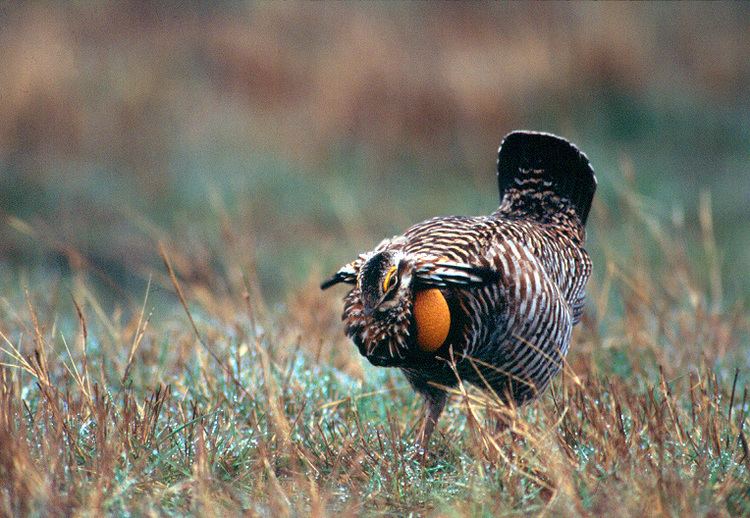Name Frances Hamerstrom | Role Author | |
 | ||
Died August 29, 1998, Port Edwards Books My double life, Walk when the Moon is Full, Is she coming too?, Wild food cookbook, An Eagle to the Sky | ||
Frances "Fran" Hamerstrom (December 16, 1907 – August 29, 1998) was an American author, naturalist and ornithologist known for her work with the greater prairie chicken in Wisconsin, and for her research on birds of prey. She was the only female graduate student of Aldo Leopold, an ecologist who wrote A Sand County Almanac. Hamerstrom was a prolific writer, publishing over 100 professional papers and 10 books on the prairie chicken, harriers, eagles, and other wildlife topics. Some were translated into German.
Contents
Biography
Frances Flint was born in 1907 into a wealthy family in Boston, Massachusetts. As a youth, she attended Milton Academy. As a child Hamerstrom developed a fascination with the natural world. Despite her father's complaint that such behavior was "unladylike", she kept wild pets and learned to hunt. To keep her family from uncovering evidence of her wildlife adventures, she planted poison ivy along the path that led to where she kept her wilderness gear. (Hamerstrom was naturally immune to its effects).
In 1931 she married Frederick Hamerstrom in secret. Later they remarried in a ceremony in Massachusetts.
Hamerstrom and her husband wanted to work with wildlife, at a time when the modern wildlife management and research profession was in its infancy. After meeting wildlife conservationist and ecologist Aldo Leopold, the Hamerstroms went to Iowa State University to study under Paul Errington, where Frederick earned a master's degree and Fran a bachelor's degree, working on the topic of predation, the food habits of the great horned owl. They moved to Wisconsin to work at a wildlife refuge and to attend graduate school under Aldo Leopold, the father of game management. Frederick Hamerstrom was one of only three men awarded a doctorate under Leopold and Frances was the only woman graduate student under Leopold to earn a master's degree. Leopold started the Hamerstroms on a study of the imperiled greater prairie chicken, an endangered species in Wisconsin.
Research
The Hamerstroms both worked for the Department of Natural Resources in Wisconsin. Their lifetime study of the endangered prairie chicken, in a research area that included the Buena Vista and Leola Marshes, was their major contribution to the field. The Hamerstroms focused on the habitat needs of the greater prairie chicken. They developed and initiated a management plan based on their observation that the prairie chicken required a "checkerboard" pattern of habitat. The Hamerstroms were recognized in 1970 with the National Wildlife Federation Award for Distinguished Service to Conservation for their innovative management plan and work with the prairie chickens.
The Hamerstroms helped focus public attention on the need for habitat preservation. In 1961 they helped form the "Society of Tympanuchus Cupido Pinnatus" (Latin term for prairie grouse) to purchase lands (a total of more than 2,000 acres) to be managed for the preservation and restoration of "native prairie grouse populations." The Hamerstroms are credited by naturalists for saving the prairie chicken from extirpation in Wisconsin. Over the years, an estimated 7,000 wildlife observers (called "boomers") participated in the collection of necessary data for this project, with Frances playing host to all of them at her home.
The harrier hawk
The Hamerstroms also conducted a decades-long study of the northern harrier. They wrote Harrier: Hawk of the Marshes, published in 1986 by the Smithsonian Institution Press. It documented the relationship between the breeding success of harriers and the vole population, which constituted their cyclical food supply.
Frances Hamerstrom was a licensed falconer. She studied American kestrels and the use of nest boxes as a management tool for kestrels, and banded thousands of raptors in Wisconsin and in other parts of North America during her many travels. She contributed to the book, Peregrine Falcon Populations: Their Biology and Decline (1998).
Wildlife author
As a writer, Hamerstrom provided insight into academic science for general readers. Among her books are:
Frances Hamerstrom was also known as a cook and published a wild game cookbook near the end of her life. Her secret for pie crusts was the use of bear lard. Her readers occasionally sent her bear lard gained from their own kills. Wildfoods Cookbook: From the Fields and Forests of the Great Lakes States was published in 1994, when she was 84, and illustrated by her daughter, Elva Hamerstrom.
By training hundreds of research assistants (nicknamed "gabboons") and by writing formal scientific papers and informal books, Hamerstrom and her husband inspired students.
Home life
The Hamerstroms lived in an 1850s-era, Plainfield, Wisconsin home. Never completed, it lacked running water and was heated by wood-burning stoves. Originally designed as a stage coach stop and community center, the structure had an incomplete ballroom on the second floor. The Hamerstroms used it as a storage area for specimens and data collected from their field research over many years.
The Hamerstroms raised two children, Alan and Elva, in their home. Hamerstrom life was far from ordinary. Fran confided to a friend who visited the house years later that "we had all the luxuries (such as a first-rate ornithological library) and none of the necessities".
She was an atheist.
Later years
Following Frederick Hamerstrom's death in 1990, Frances visited Saudi Arabia, Africa, and South America. On an expedition in Peru, at age 86 Hamerstrom broke her hip and was evacuated by helicopter. She returned to the area the following year to observe hunting practices on a tributary of the Amazon River.
Frances Hamerstrom died at a Port Edwards, Wisconsin, nursing home August 29, 1998.
